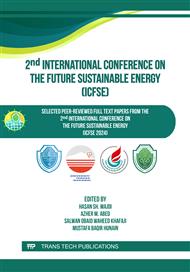[1]
O. A. Elsanusi, M. M. Roy, and M. S. Sidhu, "Experimental Investigation on a Diesel Engine Fueled by Diesel-Biodiesel Blends and their Emulsions at Various Engine Operating Conditions," Appl. Energy, vol. 203, p.582–593, 2017.
DOI: 10.1016/j.apenergy.2017.06.052
Google Scholar
[2]
S. K. Karmee et al., "Research Article Physico Chemical Analysis of Pongamia pinnata for Potential Biodiesel Source," Energy, vol. 55, no. 1, p.114–122, 2016.
Google Scholar
[3]
A. Sarin, R. Arora, N. P. Singh, R. Sarin, R. K. Malhotra, and K. Kundu, "Effect of blends of Palm-Jatropha-Pongamia biodiesels on cloud point and pour point," Energy, vol. 34, no. 11, p.2016–2021, 2009.
DOI: 10.1016/j.energy.2009.08.017
Google Scholar
[4]
N. K. C. Qing, N. A. Samiran, and R. A. Rashid, "CFD Simulation Analysis of Sub-Component in Municipal Solid Waste Gasification Using Plasma Downdraft Technique," CFD Lett., vol. 14, no. 8, p.63–70, 2022.
DOI: 10.37934/cfdl.14.8.6370
Google Scholar
[5]
R. Mobasheri, Z. Peng, and S. M. Mirsalim, "Analysis the effect of advanced injection strategies on engine performance and pollutant emissions in a heavy duty DI-diesel engine by CFD modeling," Int. J. Heat Fluid Flow, vol. 33, no. 1, p.59–69, 2012.
DOI: 10.1016/j.ijheatfluidflow.2011.10.004
Google Scholar
[6]
X. Zhang, Y. Liang, E. Yu, R. Rao, and J. Xie, "Review of electric vehicle policies in China: Content summary and effect analysis," Renewable and Sustainable Energy Reviews, vol. 70. p.698–714, 2017.
DOI: 10.1016/j.rser.2016.11.250
Google Scholar
[7]
M. Y. Kim, S. H. Yoon, and C. S. Lee, "Impact of split injection strategy on the exhaust emissions and soot particulates from a compression ignition engine fueled with neat biodiesel," Energy and Fuels, vol. 22, no. 2, p.1260–1265, 2008.
DOI: 10.1021/ef700537w
Google Scholar
[8]
A. Vanegas, H. Won, C. Felsch, M. Gauding, and N. Peters, "Experimental investigation of the effect of multiple injections on pollutant formation in a common-rail di diesel engine," in SAE Technical Papers, 2008.
DOI: 10.4271/2008-01-1191
Google Scholar
[9]
J. Jeon and S. Park, "Effects of pilot injection strategies on the flame temperature and soot distributions in an optical CI engine fueled with biodiesel and conventional diesel," Appl. Energy, vol. 160, p.581–591, 2015.
DOI: 10.1016/j.apenergy.2015.09.075
Google Scholar
[10]
R. M. Hanson, S. L. Kokjohn, D. A. Splitter, and R. D. Reitz, "An experimental investigation of fuel reactivity controlled PCCI combustion in a heavy-duty engine," in SAE Technical Papers, 2010, p.700–716.
DOI: 10.4271/2010-01-0864
Google Scholar
[11]
K. Poorghasemi, R. K. Saray, E. Ansari, B. K. Irdmousa, M. Shahbakhti, and J. D. Naber, "Effect of diesel injection strategies on natural gas/diesel RCCI combustion characteristics in a light duty diesel engine," Appl. Energy, vol. 199, p.430–446, 2017.
DOI: 10.1016/j.apenergy.2017.05.011
Google Scholar
[12]
S. Ghaffarzadeh, A. Nassiri Toosi, and V. Hosseini, "An experimental study on low temperature combustion in a light duty engine fueled with diesel/CNG and biodiesel/CNG," Fuel, vol. 262, 2020.
DOI: 10.1016/j.fuel.2019.116495
Google Scholar
[13]
U. Rajak, P. Nashine, and T. N. Verma, "Assessment of diesel engine performance using spirulina microalgae biodiesel," Energy, vol. 166, p.1025–1036, 2019.
DOI: 10.1016/j.energy.2018.10.098
Google Scholar
[14]
S. B. Fiveland and D. N. Assanis, "A four-stroke homogeneous charge compression ignition engine simulation for combustion and performance studies," in SAE Technical Papers, 2000.
DOI: 10.4271/2000-01-0332
Google Scholar
[15]
A. Kuleshov and K. Mahkamov, "Multi-zone diesel fuel spray combustion model for the simulation of a diesel engine running on biofuel," Proc. Inst. Mech. Eng. Part A J. Power Energy, vol. 222, no. 3, p.309–321, 2008.
DOI: 10.1243/09576509jpe530
Google Scholar
[16]
U. Rajak and T. N. Verma, "Influence of combustion and emission characteristics on a compression ignition engine from a different generation of biodiesel," Eng. Sci. Technol. an Int. J., no. X, 2019.
Google Scholar
[17]
A. F. A. Rasid and Y. Zhang, "Combustion Phases of Evaporating Neat Fuel Droplet," J. Adv. Res. Fluid Mech. Therm. Sci., vol. 96, no. 1, p.60–69, 2022.
DOI: 10.37934/arfmts.96.1.6069
Google Scholar
[18]
M. Mikulski and C. Bekdemir, "Understanding the role of low reactivity fuel stratification in a dual fuel RCCI engine – A simulation study," Appl. Energy, vol. 191, p.689–708, 2017.
DOI: 10.1016/j.apenergy.2017.01.080
Google Scholar
[19]
J. C. Urroz, P. M. Diéguez, G. Arzamendi, M. Arana, and L. M. Gandía, "Gaseous fueling of an adapted commercial automotive spark-ignition engine: Simplified thermodynamic modeling and experimental study running on hydrogen, methane, carbon monoxide and their mixtures," Fuel, vol. 337, 2023.
DOI: 10.1016/j.fuel.2022.127178
Google Scholar
[20]
M. M. Khan, A. Kumar Kadian, and R. P. Sharma, "Investigation of high fuel injection pressure variation on compression ignition engines powered by jatropha oil methyl ester-heptanol-diesel blends," Alexandria Eng. J., vol. 65, p.675–688, 2023.
DOI: 10.1016/j.aej.2022.10.009
Google Scholar
[21]
N. K. Frhan, A. Abboodi, and A. A. Y. Al Waaly, "Combined effect of multi ‐ injection scheme , injector nozzle bore , and biodiesel blends on combustion and performance characteristics of diesel engine," no. December 2022, 2023.
DOI: 10.1002/htj.22822
Google Scholar
[22]
P. Pavan, K. Bhaskar, and S. Sekar, "Effect of split injection and injection pressure on CRDI engine fuelled with POME-diesel blend," Fuel, vol. 292, no. May 2020, p.120242, 2021.
DOI: 10.1016/j.fuel.2021.120242
Google Scholar
[23]
V. Makareviciene, E. Sendzikiene, S. Pukalskas, A. Rimkus, and R. Vegneris, "Performance and emission characteristics of biogas used in diesel engine operation," Energy Convers. Manag., vol. 75, p.224–233, 2013.
DOI: 10.1016/j.enconman.2013.06.012
Google Scholar
[24]
J. Benajes, S. Molina, A. García, E. Belarte, and M. Vanvolsem, "An investigation on RCCI combustion in a heavy duty diesel engine using in-cylinder blending of diesel and gasoline fuels," Appl. Therm. Eng., vol. 63, no. 1, p.66–76, 2014.
DOI: 10.1016/j.applthermaleng.2013.10.052
Google Scholar



